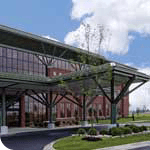
Essential Services in a Smaller Footprint
People who live far out in the country accept the inconvenience of long trips to a shopping mall or long rides on a school bus in exchange for the benefits of a rural lifestyle. But more than sixty years ago, the government decided that having to make too long of a trip to the hospital was an inequity that needed to be resolved. It committed federal dollars to the construction and improvement of hospitals in underserved areas. Then in 1997, as part of the Balanced Budget Act, Congress authorized the creation of critical access hospitals (CAH) to support the concept of small rural hospitals.
To make it financially feasible for CAHs to offer essential services despite low patient volumes, these facilities receive more generous reimbursements from Medicare and Medicaid than typical hospitals. To qualify, a CAH must meet these specific criteria:
- Provide inpatient care, emergency care, laboratory services, and radiology
- Have a maximum of 25 beds
- Be at least 35 miles from another hospital or be certified as a necessary provider
- Have a 96-hour average length of stay
- Contract with at least one physician
- Have an agreement with a network hospital for quality assurance, patient referral, credentialing, and more
Despite the reimbursements, decisions related to space, staff, and services must be driven by cost efficiency if a CAH is to be fiscally viable.
The Design Challenges of “Ins and Outs”
Larger hospitals are designed to clearly separate emergency department traffic from outpatients and visitors, and create yet another separate entrance for staff. Areas for delivery of clean materials, supplies, and food are distinct from waste and recyclables. “With the small footprint characteristic of a CAH, creating these separations is much more challenging if not impossible. We have to carefully locate service areas as far away from the “front door” as possible and, if needed, visually separate them with landscaping or architectural features,” says Robert Siebenaller, Healthcare Division Manager at SSOE.
Sharing Staff and Space
To optimize square footage, Siebenaller recommends that CAHs have a central, light-filled, public space that can handle a combination of functions. It can be the welcoming “front door” where both inpatients and outpatients enter and register and also serve as the waiting room for multiple departments, such as radiology and laboratory. Another advantage to these ”multi-purpose” spaces is that they create opportunities to share cross-trained staff.
The trend in constructing new CAHs is to keep them on one level to save the space of stairways and elevators and avoid duplication of closets, supply rooms, and consultation spaces.
Patient Rooms—Flexible yet Private
While it might be cost-effective to have semi-private patient rooms, it is a poor configuration in terms of patient care and comfort in a CAH. On any given day, patient rosters will represent both genders, a range of ages, conditions, and privacy needs that can’t be addressed by closing a curtain. Realistically, the fewer the beds, the greater the need for private rooms that can be adapted to different levels of care. The solution is to design private rooms
to be flexible—to serve as a recovery room, a delivery room, or various other specialized spaces.
Using Off-site Services
Another strategy for economizing starts with evaluating the costs of delivering services, such as laundry and food, off-site as well as the pros and cons of utilizing mobile units for a variety of clinical services. Warming kitchens use far less energy, space, equipment, and personnel than a full kitchen and they make sense in facilities having a limited number of in-patients. Mobile imaging units for CT, MRI, PET, ultrasound, and mammography are another solution. As Siebenaller points out, “Mobile units allow the hospital to rent time instead of investing in equipment that can quickly become outdated. And they are less costly than building an interior space.”
Despite the focus on economy of design, appearances should not be compromised. SSOE’s Lynne Gochenour, IIDA, AAHID explains, “We apply the same principles for designing healing environments to small rural hospitals as we do to large urban ones. These might include the selection of colors that are conducive to healing, incorporating natural light into patient rooms, and reducing noise—to name a few. The interiors need to communicate to potential staff, patients, and the community that the hospital offers quality care.”
CAHs aren’t all about working within size and budget limitations; “small” has its benefits. Unlike metropolitan hospitals, CAHs are basically free from the pressures to compete with neighboring medical facilities. Also, many decisions are made by the hospitals’ staff and community rather than a board of directors making many of the approximately 1,300 CAHs nationwide a source of local pride.
To learn more about how SSOE can help with your healthcare facility, contact Robert Siebenaller (rsiebenaller@ssoe.com).
